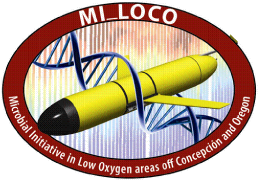 ©2020 Biological and Chemical Oceanography Data Management Office.
©2020 Biological and Chemical Oceanography Data Management Office.Funded by the U.S. National Science Foundation
Two Oxygen Minimum Zones are studied in this project. One is along the Oregon Coast, USA (44.25°N, 124.25°W), and the other is off the coast of Concepción, Chile (36.513°S, 73.129°W).
Microbial Initiative in Low Oxygen areas off Concepción and Oregon
Although Eastern Boundary Current Ecosystems (EBCE) represent less than 5% of the ocean’s surface, they support regions of high biological activity that contribute significantly to global elemental cycles. Of particular interest in these regions is the strong role that microbial assemblages play in the production and transport of organic matter from the well-lit surface layers into the deeper ocean environment where it is remineralized.
Naturally occurring regions of hypoxia found along the EBCE support microbial communities that strongly affect marine and global biogeochemical cycles. Some of these largest regions, also known as Oxygen Minimum Zones (OMZs), are found in the upwelling areas of these EBCE along the North and South Pacific Ocean where their intensity, thickness, and temporal stability varies as a function of latitude.
With the support of the Gordon and Betty Moore Foundation (GBMF, Palo Alto, California), a project was proposed to study the OMZ along the coast of Oregon-USA and Concepción-Chile.
With this study we will understand the spatial and temporal variability of the OMZ along both the Oregon and Concepción regions, and their associated mechanisms, by integrating Physical, Biogeochemical, Microbial, and Paleo-oceanography. The outcome of the proposed effort will allow us to identify similarities and distinctions between the microbial assemblages inhabiting both regions, characterize physical and biogeochemical seasonal patterns in the development and maintenance of hypoxic zones over both shelves, and determine the long term changes in the seasonal fluctuation of oxygen concentration over the shelves with the use of paleo proxies.
Our study is aimed at developing databases to:
- compare the marine microbial assemblages associated with the seasonal hypoxia observed on the continental shelf off Concepción, Chile, and Oregon, USA, and
- assess potential use of paleoceanographic approaches to characterize the interannual and long-term variability in local oceanographic physical, chemical, and biological conditions driving the development of these hypoxic coastal environments.
This project is an integrated effort between researchers at Oregon State University (OSU), Universidad de Concepción (UdeC), Aarhus University (AU), Massachusetts Institute of Technology (MIT), and the University of Pennsylvania (Penn). Results from this proposed effort will significantly complement ongoing marine microbial and biogeochemical studies supported by the Agouron Institute in the permanent OMZ off northern Chile and Peru (ESP-OMZ Website).
Centro de Estudios Oceanográficos en el Pácifico Sur-oriental (COPAS Website)
El Laboratorio de Procesos Oceanográficos y Clima (PROFC Website)
Funding:
Gordon and Betty Moore Foundation (GBMF) Grant # 1661 (11/01/2008 to 11/01/2012)
Justification for using OCE-1260164 for COPAS and MILOCO Written by Ricardo Letelier:
There are two connections from OCE that support the inclusion of COPAS and data in BCO-DMO, as the data relates to OCE. Because COPAS is one of the longest oceanographic biogeochemical/physical time-series in South America, the data generated by this program is useful for time-series comparative studies. As such, some of us - myself included - are interested in comparing general temporal patterns and trends. Hence, we could use our present HOT time-series grant to support this effort in order to access the data.
The second one is the connection with the work of Ed Delong as part of MI_LOCO and C-MORE. The microbial diversity analysis, as a function of biogeochemical gradients is an integral part of both projects. One of the C-MORE cruises took place in the OMZ off Chile and the data collected by MI-LOCO allows us to place our results into a broader temporal context.
| Dataset | Latest Version Date | Current State |
|---|---|---|
| SeaGlider dive data from the Oxygen Minimum Zone off Concepcion Chile; 2009-2011 (MI-LOCO project) | 2014-01-24 | Final no updates expected |
| SeaGlider surface data the Oxygen Minimum Zone off Concepcion Chile; 2009-2011 (MI-LOCO project) | 2014-01-24 | Final no updates expected |
| Station locations from MI-LOCO project cruises off the coast of Chile (Oxygen Minimum Zone off Concepcion Chile); 2009-2011 (MI-LOCO project) | 2013-07-24 | Final no updates expected |
| Station locations from MI-LOCO project cruises off the coast of Oregon, Oxygen Minimum Zone off the Oregon coast, USA; 2009-2011 (MI-LOCO project) | 2013-02-07 | Final no updates expected |

Lead Principal Investigator: Ricardo Letelier
Oregon State University (OSU)
Principal Investigator: Matthew J. Church
University of Hawaiʻi at Mānoa (SOEST)
Co-Principal Investigator: Osvaldo Ulloa
Universidad de Concepcion (UdeC)
Project Coordinator: Kristen Milligan
Oregon State University (OSU)
Contact: Ricardo Letelier
Oregon State University (OSU)
Data Manager: Jasmine Nahorniak
Oregon State University (OSU)
BCO-DMO Data Manager: Stephen R. Gegg
Woods Hole Oceanographic Institution (WHOI BCO-DMO)